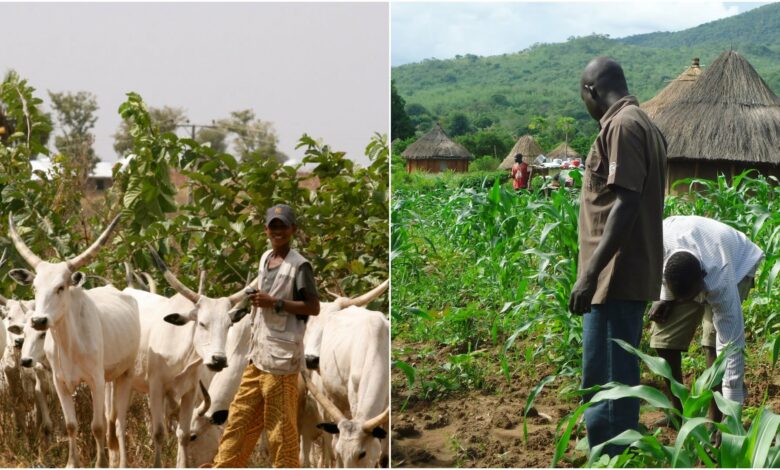Livestock Plan Promises Solution To Herder-farmer Clashes

The pilot implementation of the National Livestock Transformation Plan (NLTP) has shown promising results in federal government efforts to end the lethal conflict between farmers and herders.
Some beneficiaries of the scheme who spoke to LEADERSHIP have hailed federal government and donor agencies over the establishment of model ranch and modernisation of grazing reserves in their community, adding that the scheme has helped them achieve peace, create more jobs and transform the livestock sector for economic gains.
The federal government with support from the Food and Agriculture Organisation (FAO) of the United Nations recently began pilot implementation of the ten-year NLTP with the aim to confine cattle, boost livestock production and put an end to the age-long herders-farmers conflict.
It is estimated that the plan, which aims to have at least 119 modern ranches operating in all participating states by 2028, will create more than 2million jobs in the livestock production, processing and marketing chains as pastoralists will be persuaded to move their cattle into ranches and public grazing reserves.
The NLTP pilot schemes in Kaduna and Niger states seek to increase household incomes through improved livestock productivity, strategic marketing and sustainable value chains.
In an interview with LEADERSHIP, Umar Abubakar, herder and owner of 50 cows in one of the pilot schemes, Sheyi Grazing Reserve in Niger State expressed delight over the peaceful co-existence between them and farmers since the commencement of activities in the reserve.
Umar added that they no longer move around and struggle to feed their cattle as the capacity training on the modernised ranch has helped them improve feed production for their livestock.
He said, “The ranch is very useful to us, we have learnt the modern way of producing feed for our cattle, how to plant and how to source their feed. If we are able to sustain this project, it will help us reduce travelling with our cattle and by extension stop the conflict between us and the farmers”.
“With the grazing reserve, our cattle feed well and we thank the FAO and the federal government for providing the project for us, we urge them to sustain it for us and also extend the project to other states where our brothers will benefit because we are tired of the conflict between us and the farmers,” Umar added.
According to Umar, most state governments especially those who are still skeptical about the plan should embrace it as an opportunity to foster peaceful co-existence between farmers and herders and enhance the nation’s economic prosperity.
While appealing to other herders to embrace grazing reserve, another herder, Gambo Isa, who owns 20 cows and live in Sheyi Grazing Reserve, said the modern grazing method has transformed their businesses, adding that grazing within the reserve area is the only way to bring peace and achieve more gains in the grazing business.
“The training has helped us very well, I am appealing to other herders who are not currently in reserve to embrace the project when it comes to their state, this will help us achieve the needed peace and even help us produce more cattle and gain more in the business.
We are now living in peace with farmers in this area, so we appreciate the training they have given us, we have seen a lot of benefits from the training regarding improving our animals and milk production,” Isa said.
“We really enjoy the way we now store the feed especially to feed the animals in dry season, we no longer go far to feed them, they eat well and grow very fat and through that, we produce more milk ranging from two-to-three litres per day unlike before. We now live peacefully with farmers because we stopped moving about. Farmers even call us to graze on their crop residual after harvest,” Isa added.
With one hundred beneficiaries for the off take of the scheme, the three-hectares modernised ranch at Sheyi Grazing Reserve has a solar powered borehole, perimeter chain-link fence, two hectares of pasture, irrigation facilities and accommodation for extension workers, training shed, hay barn, crush and pasture development and is expected to serve as a hub for the production of improved feed for livestock.
While the Kaduna pilot ranch sits on nine-hectares of land with the same attendant benefits and in addition, a capacity training for farmers and herders on the good practices for optimal livestock production.
Experts in the livestock sector believe that full implementation of the scheme will put an end to the age-long conflict between farmers and herders which is largely due to scramble for scarce resources to feed cattle.
Speaking to LEADERSHIP, national president of All Farmers Association of Nigeria (AFAN ) Arc Kabir Ibrahim said the national livestock transformation plan, when totally implemented will confine cattle and mitigate farmers-herders clashes and the disruption of the peace of the nation.
A feed dealer in Sheyi Grazing Reserve, Laria Yusuf, told LEADERSHIP that the grazing reserve was very useful to them, as it has helped them produce more feed to sell especially when they practice the modern way of feed production they learnt during the training.
“We are empowered to produce grass for cows through the training, so now herders come to buy in large quantities and we make two thousand naira per 50kg bag of grass,” he said.
A farmer and a member of the host community to the ranch, Salamatu John who spoke to LEADERSHIP also said she benefited from the grazing reserve by selling crop residue, cassava peels and other alternative feed.
She said the establishment of the ranch has brought diverse value chains, which ensure a win -win situation for herders and farmers, which according to her have fostered peaceful co-existence.







